Table of contents
Wheat gluten, originally developed in Japan , is one of the most concentrated, purely plant-based protein sources due to its production process. Organic seitan products are particularly popular in vegetarian and vegan diets.
Using wheat gluten in the kitchen:
What is a good meat substitute? Wheat gluten (mianjin, wheat protein, wheat meat) is a tasty, purely plant-based meat alternative (meat substitute) with a firm consistency. Seitan can be used in many different ways in the kitchen.
What is seitan made of? Seitan (Mianjin) consists of the water-insoluble gluten protein in wheat flour. This can be used to make wheat gluten products such as burgers, seitan schnitzels, sausages or cold cuts. You can also replace shashlik skewers for grilling or salami on pizza with the so-called wheat meat. Finely chopped, seitan is used as a minced meat alternative in lasagne, pasta sauce and meatballs, for example. Cut into slices or pieces, wheat gluten can be baked in the oven, deep-fried in batter (tempura), grilled or pan-fried. Whether as a soup garnish, in a stew or in wok dishes, the possible uses of Mianjin are almost limitless. 1
Can you eat seitan raw? Mianjin is not edible raw: homemade raw seitan must be cooked before further processing - commercially available wheat gluten is already cooked.
What does seitan taste like? Since wheat gluten itself has a very neutral taste, it is usually marinated and seasoned with salt and spices. There are numerous wheat gluten recipes on the Internet.
Vegan recipe for seitan strips with spaetzle:
Ingredients (for 4 people): 400 g seitan (Mianjin, organic), 500 g mixed mushrooms, 1 tsp instant vegetable stock, 400 ml oat cream, 500 g spaetzle (vegan), 1 clove of garlic, 2 shallots, 1 tbsp tomato paste, 1 tbsp refined rapeseed oil, salt, nutmeg,black pepper, 3 sprigs of fresh thyme.
Preparation : First cut the seitan into strips. Finely chop the garlic and shallots, then clean and slice the mushrooms. Heat the oil in a large pan and fry the mushrooms briefly. Next add the seitan, shallots and garlic and fry them. Then deglaze everything with oat cream and add the tomato paste. Let the mixture simmer for 4-5 minutes. At the same time, prepare the vegan spaetzle in boiling salted water according to the instructions on the packet. Add 1-2 ladles of the spaetzle water to the strips and bring the whole thing to the boil again until the sauce thickens. Season the strips with salt, pepper, vegetable stock and nutmeg. Finally, wash the thyme, pat dry and chop finely. Serve the spaetzle with the strips and sprinkle the thyme on top.
Vegan recipe for sweet and sour wheat gluten:
Ingredients (for 2 people): 300 g seitan (organic), 2 tbsp peanut oil (alternatively rapeseed oil), 2 onions, 1 red bell pepper, 1 carrot. For the sauce: 75 ml vegetable stock, 4 tbsp ketchup, 2 tbsp apple cider vinegar, 3 tbsp rice wine (if available), 2 tbsp soy sauce, 2 cloves of garlic, ½ tsp ground white pepper, 2 tsp corn starch. As a topping: 1 spring onion, 2 tsp light sesame seeds.
Preparation: First tear the seitan into small pieces. Roughly chop the onions and peppers and cut the carrots into sticks. Fry the seitan in 1 tablespoon of oil for about 5 minutes, stirring constantly, then set aside. Add the remaining oil to the pan and fry the onions while stirring, add the peppers and carrots and fry for a few minutes. For the sauce, finely chop or press the garlic and stir with the other ingredients until smooth. Reduce the heat a little, add the seitan to the vegetables, add the sauce and bring to the boil briefly, then simmer for about 5 minutes. Serve the sweet and sour seitan sprinkled with finely chopped spring onions and sesame seeds.
Vegan recipes with wheat gluten can be found under the note: " Recipes that have the most of this ingredient ".
| Not only vegans or vegetarians should read this: Vegans often eat unhealthily. Avoidable nutritional errors. |
Shopping - where to buy wheat gluten?
More and more supermarkets and wholesalers are stocking the vegan meat substitute Mianjin (also known as wheat meat or wheat protein) in their range. At Coop, Migros, Denner, Volg, Spar, Aldi, Lidl, Rewe, Edeka, Hofer etc. you can often buy not only "natural" seitan, but also a large selection of ready-made products made from wheat gluten, such as vegan nuggets, sausage, sausage spread, minced steak, schnitzel, minced meat, fillets etc. Organic seitan can be found in health food stores, organic shops, organic supermarkets (such as Denn's Biomarkt, Alnatura), drugstores, specialty stores or online. There are also basic mixtures made from gluten flour, which you just mix with water to quickly make your own seitan.
To give the neutral wheat gluten flavor, organic seitan usually contains soy sauce in addition to wheat flour, wheat protein, water, sea salt and spices. Many conventional manufacturers also add large amounts of salt, sugar, flavors, colorings and flavor enhancers to the seitan composition. We therefore recommend that you take a look at the ingredients before buying and opt for organic wheat gluten. If you want even more control over the seitan ingredients, you can simply make the wheat gluten yourself. 2
Making your own wheat gluten:
How do you make seitan yourself? Wheat gluten is very easy to make yourself. To make seitan, first mix 1 kg of white, fine wheat flour (e.g. type 405, organic) with 750 ml of water and process the whole thing into a smooth dough, ideally with a hand mixer. The dough should now rest covered for 3 hours. Then add another 1 liter of water and start kneading the dough. The water should turn milky over time, because when it is "washed out", the starch contained in the dough dissolves and the dough falls apart. After a few minutes, pour off the water, knead the piece of dough again and add more water. Repeat this process until the water no longer turns milky. What remains is the rubbery, sticky wheat protein. 3
An even simpler method for making seitan is to use gluten flour (gluten powder) instead of wheat flour. Since the gluten flour no longer contains any starch, there is no need to "wash out" the dough. All you have to do is mix equal parts of water and flour in a bowl and knead into a smooth dough.
For more flavor, you can refine the raw seitan with salt and spices or marinate it with soy sauce, herbs and spices. Then the dough must be boiled in the broth or cooked in batches in the steamer for about 1 hour. Steaming gives it its firm, meaty, slightly chewy consistency.
Storing wheat gluten:
Seitan should always be kept in the refrigerator. Purchased seitan products last significantly longer than freshly prepared wheat gluten. It is best to use the best-before date shown as a guide. Fresh wheat gluten can be stored in an airtight container in its own cooking liquid for a week. Frozen in the freezer, the "meat made from wheat" will last for up to eight weeks.
Seitan ingredients - nutritional values - calories:
Seitan has 370 kilocalories (kcal) per 100 g. These wheat gluten nutritional values come mainly from protein, which makes up a large part of wheat gluten at 75%. At 14%, the proportion of carbohydrates is higher than in soybeans (11%), but much lower than in the raw material for seitan, wheat flour (77.3%). Wheat gluten contains little fat at 1.8%. 4
100 g of wheat gluten contains 40 µg of selenium. This covers 72% of the daily requirement. The amount can be compared with the amount in barley groats or germinated wheat. Wheat germ contains slightly more (79 µg/100g) and mustard powder has significantly more (208.1 µg/100g). The content in Brazil nuts (1,917 µg/100g) is so high that 1-3 of those from Bolivia are enough to cover the average daily requirement. 4 The semi-metal is very sparsely present in the soil in some regions, where deficiency symptoms can certainly occur. But too much selenium is also possible and can accumulate in plants (Brazil nuts from Brazil contain significantly more selenium). Selenium plays an important role in the human body for the antioxidant protection system, the immune system and thyroid metabolism. 5,6
The daily requirement of phosphorus is covered by 37% with 260 mg per 100 g of wheat gluten. Chickpeas and corn semolina achieve comparable values. Hemp seeds (1,650 mg/100g) and poppy seeds (870 mg/100g) contain a lot of the macronutrient. 4 The body needs phosphorus for energy production and storage and for maintaining normal blood pressure, among other things. 7,8 Many ready-made products and non-alcoholic drinks contain high amounts of phosphoric acid and other phosphate additives, which is why an excess is more likely to occur. However, the requirement can be covered much better with a natural and balanced vegan diet.
By consuming 100 g of seitan, you can cover 37% of your daily iron requirement. The proportion of 5.2 mg/100g is comparable to tofu and sunflower seeds. Spices such as cumin (66.3 mg/100g) and turmeric (55 mg/100g) have a particularly high iron content, but wheat bran also has twice as much iron as seitan at 11 mg/100g. 4 The trace element iron is involved in oxygen transport in the blood, oxygen storage in the cells and energy metabolism. 9
It also contains copper and calcium.
The complete ingredients of wheat gluten, the coverage of the daily requirement and comparison values with other ingredients can be found in our nutrient tables. In the article Nutrients explained you will get a detailed insight into the topic.
Health aspects - effects:
Is seitan really healthy? Seitan is considered a healthy substitute for meat due to its high protein content (wheat protein). However, the body is less able to utilize the protein it contains than, for example, that in tofu. If you season seitan with soy sauce, the lysine it contains can improve its biological value and therefore absorption somewhat. But isolated products such as wheat protein are hardly recommended for a balanced diet, because these products lack important vitamins, minerals and fiber. In addition, there are the additives in industrially produced products. Organic products do better here, but even with them, too much protein can also harm the body. 13
The high protein content ensures a long-lasting feeling of satiety, which leads to a lower calorie intake. Since seitan has a low fat content and is almost cholesterol-free, it is also recommended for people who want to reduce their weight. Studies show that people who eat a vegan diet consume significantly less cholesterol. 16 This diet can also help to reduce high LDL cholesterol levels. 17
Dangers - Intolerances - Side effects:
Is seitan gluten-free or does seitan contain gluten? It can be clearly denied that seitan is gluten-free, because seitan consists mainly of the gluten protein. How dangerous is seitan? Seitan is unhealthy for people who suffer from celiac disease, gluten sensitivity or gluten intolerance, so they must avoid wheat protein.
What is celiac disease? If you have celiac disease, you react with intolerance to the grain protein gluten and should therefore refrain from eating it. The disease is defined as a food intolerance that triggers an autoimmune reaction in genetically predisposed patients. 10 The disease has been known for many years. Before the trigger was found, the mortality rate was 60%. The best treatment option currently is a change in diet to avoid gluten completely. Celiac disease can occur in both childhood and adulthood. Gluten is not only found in products made from gluten-containing grains ( flour, semolina, groats or pearl barley), it is also frequently used as an additive in other foods and in medicines. Those affected should therefore read the ingredients carefully before buying a product. Gluten-free alternatives include wild rice, corn, rice, millet and pseudocereals such as buckwheat, quinoa and amaranth. 10
People who suffer from a rare wheat allergy should also avoid seitan. Since the body perceives the protein contained in wheat as a threat, it produces antibodies to fight it. The diverse symptoms range from fatigue, nausea, stomach pain, flatulence and diarrhea to skin reactions such as rashes and itching. 11
Occurrence - origin - ecology:
Where does seitan come from? Wheat gluten is a very old food that has its origins in the Japanese-Chinese Zen tradition. Centuries ago, vegetarian monks are said to have used seitan as a meat substitute. However, the term 'seitan' was not established until much later by the Japanese philosopher Georges Ohsawa. The word is made up of the syllable 'Sei', which means something like "life" or "made of", and 'Tan', which can be translated as "protein". In summary, seitan means "made of protein".
Cultivation - Harvest:
Wheat gluten (wheat meat) is made from the following ingredients: wheat flour and water. It is advisable to ensure that the wheat plants are grown organically and regionally. Since wheat is susceptible to fungi, bacteria and diseases, farmers in conventional cultivation use pesticides and weed killers to minimize yield losses. 12 Organic wheat cultivation is now well established. High-quality organic wheat places high demands on soil, nutrients and crop rotation. 14
Ecological aspects:
According to the Sustainable European Research Institute ( SERI), seitan has a slightly worse ecological balance than tofu. Growing wheat requires around ⅓ more land than growing soy. In addition, CO 2 emissions are around 50% higher than when producing tofu. However, compared to conventional meat, both alternative products are significantly less harmful to the environment. 15
When buying wheat gluten, make sure that it is organic and that the wheat is grown locally.
General information:
The so-called 'Fu' is a Japanese variation of seitan. Fu means something like gluten. To make it, the seitan is roasted, steamed and dried and then stored in a cool place. To be able to use it later in dishes, the Fu is first soaked in hot water and then the excess water is squeezed out well. Now you can use it again like normal seitan.
You can now also find seitan made from spelt in stores or make it yourself from spelt flour.
Alternative names:
Wheat gluten or seitan can also be found as "wheat meat", wheat protein or mianjin, often incorrectly written as seitan. The term seitan has only been around since the 1960s. Outside Switzerland, it is also written in German as wheat protein (Eiweiß).
In English, wheat gluten is called wheat meat, gluten meat or wheat gluten. Vital wheat gluten or gluten is the so-called gluten flour that is used to make seitan or added to baked goods to achieve more elasticity. In Chinese, wheat gluten is called miàn jīn and in Korean as milgogi.
Keywords for use:
Wheat gluten also serves as an additional protein source in various fish and meat preparations (cold cuts, surimi, etc.) and as a binding agent in the production of animal feed (mainly for pets). Some athletes use wheat gluten to build muscle.
Literature - Sources:
Bibliography - 17 Sources (Link to the evidence)
| 1. | Seitan.info. Verwendung von Seitan. |
| 2. | Eatsmarter.de. Seitan Warenkunde. |
| 3. | Smarticular.net Seitan herstellen aus Mehl - Fleisch-Alternative ohne Soja. |
| 4. | USDA United States Department of Agriculture. |
| 5. | Avery JC, Hoffmann PR. Selenium, selenoproteins, and immunity. Nutrients. 1. September 2018;10(9). |
| 6. | Stuss M, Michalska-Kasiczak M, Sewerynek E. The role of selenium in thyroid gland pathophysiology. Endokrynol Pol. 2017;68(4):440–65. |
| 7. | Brautbar N, Carpenter C, Baczynski R, et al. Impaired energy metabolism in skeletal muscle during phosphate depletion. Kidney Int. Juli 1983;24(1):53–7. |
| 8. | Foster BL, Tompkins KA, Rutherford RB, et al. Phosphate: known and potential roles during development and regeneration of teeth and supporting structures. Birth Defects Res C Embryo Today. Dezember 2008;84(4):281–314. |
| 9. | Abbaspour N, Hurrell R, Kelishadi R. Review on iron and its importance for human health. J Res Med Sci. Februar 2014;19(2):164–74. |
| 10. | Smollich M, Vogelreuter A. Nahrungsmittelunverträglichkeiten. Lactose-Fructose-Histamin-Gluten. Verlag: Wissenschaftliche Verlagsgesellschaft: Stuttgart. 2. Auflage 2018. |
| 11. | Lebensmittelunvertraeglichkeiten.de Weizenallergie. |
| 12. | Pflanzenforschung.de. Weizenanbau. |
| 13. | UGB-Forum Unabhängige Gesundheitsberatung. Ist Seitan eine sinnvolle Alternative zu Steak? |
| 14. | Oekolandbau.de Ökologischer Weizenanbau. |
| 15. | Umweltbundesamt. Die Zukunft im Blick: Fleisch der Zukunft. 2019. (PDF). |
| 16. | Bradbury KE, Crowe FL et al. Serum concentrations of cholesterol, apolipoprotein A-I, and apolipoprotein B in a total of 1 694 meat-eaters, fish-eaters, vegetarians, and vegans. Eur J Clin Nutr. 2014 Feb;68(2):178–83. |
| 17. | Ferdowsian HR, Barnard ND. Effects of plant-based diets on plasma lipids. American Journal of Cardiology. 2009 Oct 1;104(7):947–56. |

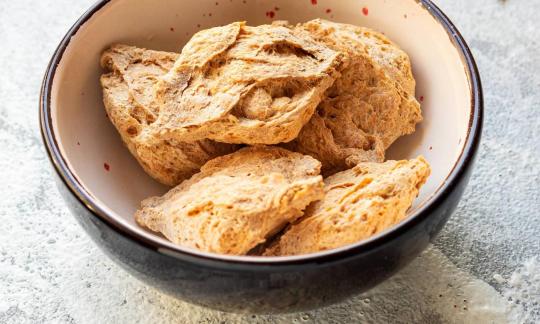

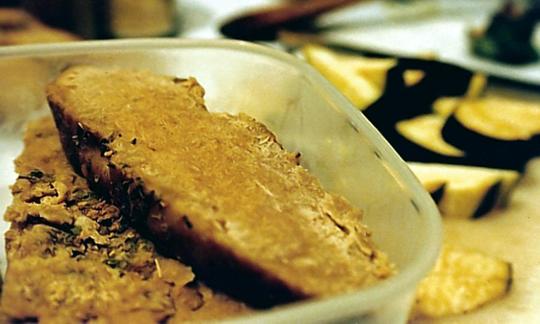

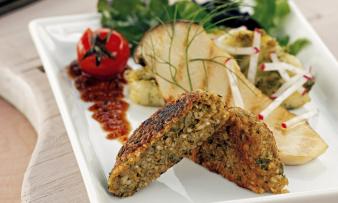
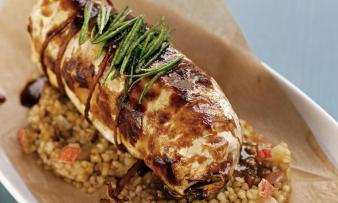
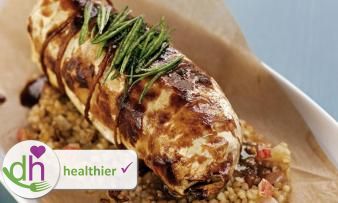
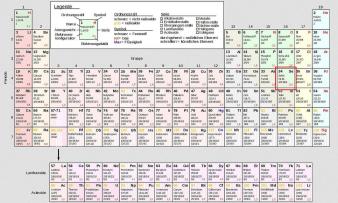

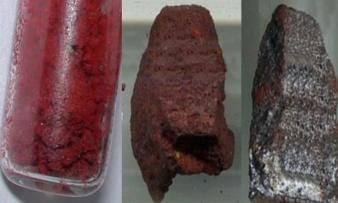


Comments